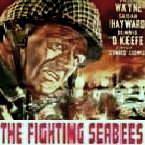Ian R
Posts: 3420
Joined: 8/1/2000
From: Cammeraygal Country
Status: offline

|
Here is an example of about "as good as it gets" coordination in 1942, with a two-carrier USN TF. That is almost a 100% strike package (?? with 5/72 SBDs and 1/18 TBF unavailable). Even the escorts (36 airframes each, on 60% CAP/40% escort) have maxed. You don't get this very often, though, there are too many checks/die rolls in the way.
quote:
Afternoon Air attack on TF, near Jarvis Island at 166,141
Weather in hex: Heavy rain
Raid spotted at 19 NM, estimated altitude 15,000 feet.
Estimated time to target is 7 minutes
Allied aircraft
F4F-3 Wildcat x 14
F4F-4 Wildcat x 14
SBD-3 Dauntless x 67
TBD-1 Devastator x 18
TBF-1 Avenger x 17
Allied aircraft losses
SBD-3 Dauntless: 2 damaged
Japanese Ships
CL Kashima, Bomb hits 3, on fire, heavy damage
DD Yamagumo, Bomb hits 2, and is sunk
CL Kinu, Bomb hits 4, heavy fires, heavy damage
DD Shirakumo, Torpedo hits 1, and is sunk
Aircraft Attacking:
3 x SBD-3 Dauntless releasing from 3000'
Naval Attack: 1 x 1000 lb SAP Bomb
4 x SBD-3 Dauntless releasing from 4000'
Naval Attack: 1 x 1000 lb SAP Bomb
18 x TBD-1 Devastator launching torpedoes at 200 feet
Naval Attack: 1 x 22in Mk 13 Torpedo
8 x SBD-3 Dauntless releasing from 3000'
Naval Attack: 1 x 1000 lb SAP Bomb
4 x SBD-3 Dauntless releasing from 4000'
Naval Attack: 1 x 1000 lb SAP Bomb
17 x TBF-1 Avenger launching torpedoes at 200 feet
Naval Attack: 1 x 22in Mk 13 Torpedo
8 x SBD-3 Dauntless releasing from 2000'
Naval Attack: 1 x 1000 lb SAP Bomb
8 x SBD-3 Dauntless releasing from 3000'
Naval Attack: 1 x 1000 lb SAP Bomb
5 x SBD-3 Dauntless releasing from 3000'
Naval Attack: 1 x 1000 lb SAP Bomb
5 x SBD-3 Dauntless releasing from 4000'
Naval Attack: 1 x 1000 lb SAP Bomb
1 x SBD-3 Dauntless releasing from 2000'
Naval Attack: 1 x 1000 lb SAP Bomb
1 x SBD-3 Dauntless releasing from 4000'
Naval Attack: 1 x 1000 lb SAP Bomb
4 x SBD-3 Dauntless releasing from 2000'
Naval Attack: 1 x 1000 lb SAP Bomb
8 x SBD-3 Dauntless releasing from 10000'
Naval Attack: 1 x 1000 lb SAP Bomb
4 x SBD-3 Dauntless releasing from 10000'
Naval Attack: 1 x 1000 lb SAP Bomb
4 x SBD-3 Dauntless releasing from 10000'
Naval Attack: 1 x 1000 lb SAP Bomb
Heavy smoke from fires obscuring CL Kinu
Heavy smoke from fires obscuring DD Yamagumo
Magazine explodes on DD Shirakumo
Heavy smoke from fires obscuring a Japanese CL
Heavy smoke from fires obscuring DD Shirakumo
_____________________________
"I am Alfred"
|
 Printable Version
Printable Version











 New Messages
New Messages No New Messages
No New Messages Hot Topic w/ New Messages
Hot Topic w/ New Messages Hot Topic w/o New Messages
Hot Topic w/o New Messages Locked w/ New Messages
Locked w/ New Messages Locked w/o New Messages
Locked w/o New Messages Post New Thread
Post New Thread